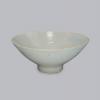Delftware Vase, Netherlands, tin-glazed earthenware with underglaze blue decoration (c. 1680)
Commentary
Delftware takes its name from the Dutch City that acted as its main production centre. It is a form of northern European tin-glazed earthenware, almost exclusively decorated by hand in blue on a white background. It was produced from the seventeenth century onwards and designed in the image of Chinese porcelain. Delftware was significantly cheaper than Chinese porcelain to produce, and quickly became a commercial industry with huge imports by the Dutch East India company. The popularity of Delftware illustrates the shift of Europe’s economic centre away from the Mediterranean, and towards western Europe.
This vase is an example of the work from the Transitional period (1620-80), and imitates Chinese vases of the Ming dynasty (1368-1644). It depicts a scene of scholars set in a landscape. While this is a scene commonly found on Chinese porcelain, the tulips on the vase’s neck indicate its Dutch origin.

